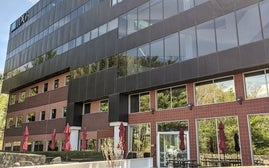Precision Engineering looks to rebound from slow year
 WBJ File
Liora Stone, president, Precision Engineering
WBJ File
Liora Stone, president, Precision Engineering
Nearly 30 years ago, Liora and Peter Stone were newlyweds who decided to start a metal fabrication company out of their garage. When Peter Stone went to give his notice at the structural fabrication company where he was working, his boss had a different idea: were Peter and Liora interested in buying his company instead?
It turns out they were. The Stones scrounged together the money for a down payment on the company and within a month hired their first employee. Today, Precision Engineering is an Uxbridge metal fabricator with in-house coating capabilities. Business was slow this year, and the company had to lay off about 15 employees, but things have picked up since the end of the election, and if things stay on track, the workforce could grow by 15 to 20 percent over the next six months.
Liora Stone spoke about the early years balancing the company with her nursing career, the advantages of having in-house powder coating, and how the global market influences Precision’s bottom line.
Why did you and Peter decide to buy the company 30 years ago?
I was working full time as a nurse, carrying insurance and supporting the two of us. He started, he took over customers that this guy had and I was doing all the paperwork. A month into it, we hired our first employee. He’s still with us as plant manager and chief guy our floor. I did all of the invoicing, accounts payable and payroll. Within a year, we had five employees. On the weekends, or at night, whenever I wasn't working [as a nurse], I was doing paperwork. I was like the office administrator. I did that for a long time. About maybe 2.5 years later, I got pregnant and was going to have a baby, but I was still working full time, so we hired someone to help me in the office, to do payroll, human resources, receivables and order entry.
Slowly it kind of grew. About 10 years into it, I couldn't keep up with pace anymore, so I came aboard full time and left nursing.
But now you're president and he's vice president. When did that switch happen?
I was always co-owner, we were a 50/50 proposition, for about maybe 15 years. For roughly 15 years we were 50/50 owners. He was president and I was vice president. We changed it to me being president, and about maybe 10 years ago, at the urging of a couple of our big clients, we became certified woman-owned. I owned 51 percent of the company and he owned 49.
Why did you switch titles?
I was doing a lot of the contract negotiations, I was doing all the check writing, I was doing the real financial types of things, and the contracts, and it just became easier, more important, and better for me to be president of the company. He was always chief operations officer. I was acting more like chief executive officer. We always make the deals together, but I'm always finalizing and signing those sorts of things.
What are the advantages of being certified women-owned?
The short of it is you get opportunities to meet with clients you wouldn't be able to meet with otherwise. I was able to then connect with companies at different diversity matchmaking events that I wasn’t able to before. And then when you're talking to those clients, and you're competing for a job, when it's between you and another company and everything else is equal, it might be something that gives you a leg up. They need to meet certain quotas, and if they're not meeting a part quota. Everything else being equal, but I’ve got that one extra thing the competitor does not have.
Definitely helps with networking. Last week I was at a small business event. Every once in awhile I go to a thing geared towards diverse suppliers – woman-owned, minority-owned. I go to events like these as well as small business events.
What industries does Precision serve?
Really a wide range, but when you boil it all down, the majority of them are original equipment manufacturers. They’re generally making some kind of electronic device, for example, we serve two companies that make fire suppression and security systems. We work with one company that manufactures elevators. Another is a lighting company that designs and manufactures lighting systems for big stores like Target or Walmart. We work with another company that manufactures battery systems. One of the metal components we’re working on now is going into hospitals. We’re working with the company that won the bid for the [MBTA] Orange and Red Line projects. We’re working on components for the subway cars themselves.
It’s really wide ranging – transportation, fire suppression, security systems, medical devices. They’re all original equipment manufacturers, making some sort of electronic device that makes a metal box and metal component.
We help them tweak the product so it functions right. Sometimes an engineer will make something and when you go to manufacture, there are issues. We'll help them tweak the design so it’s easier to manufacture, and you don't waste time and money.
One of the big differentiators for us is lot of small- to medium-sized metal fabricators don’t have in-house powder coating capabilities, which we do. It makes us more of a one-stop shop for our customers.
What are some advantages of having in-house powder coating capabilities?
For one thing, you can control the quality. You're doing the work. The other major thing is lead time. If I have to make the product and send it out to powder coater, it's going to take time for me to send it to them. Now I have to double check it and make sure its not damaged and coated correctly, that’s time and time is money. That’s a way for us to keep costs down and keep quality at a higher level for the customer.
With respect to the product we make, custom metal fabrications, which include enclosures, components, bracketry, panels and electro-mechanical assemblies.
How many employees do you have?
We’re down to about 30 right now. We had a really slow summer. We had to cut back on the workforce. But I see us getting up to right under 50 very soon. Last spring we were at like 45 employees. The summer was particularly slow, across all industries.
We’re back to getting busy again, now that the election is over.
Why was there such a big slowdown?
Part of it was the election and other economic issues. There has been corporate restructuring for some of our bigger clients. We truly do live in a global world, sometimes I don't even know what was causing it.
A lot of our clients are publicly traded and are very in tuned to the cost of doing business in the United States. They can go anywhere in the world. They frequently do corporate restructuring, which is taking divisions within their companies and changing them, and the election ties into that because they are in tuned to “What's the next administration going to do in terms of taxes and regulations?” things like that.
Right now we’re still kind of taking it slow. Orders are starting to pick up again, but it’s been a slow ride. If things continue, we anticipate increasing the workforce by 15 to 20 percent in the next six months.
Does this typically happen in election years?
It does happen during election years, but this year was a particularly big drop in revenue, drop in orders. I think there were a lot of global economic issues. Part of it could be security concerns, part of it could be related to Brexit. Who knows? One of our companies got bought out by a company that wanted to do a corporate inversion. These cycles do happen. Some people had it in 2004, we all had it after 9/11. These things could happen, it comes back, you have to be able to weather that storm.
In 2009, President Barack Obama was elected, and the recession was still going on. We were okay then but there were several people in the room saying 2009 was really bad for them.
How do you weather the storm when something like that happens?
The first thing is to try to anticipate it so you're not blindsided, which is not easy to do. React as quickly as possible. The most immediate thing you have to do is cut expenses. Layoffs. Maybe if people are organically leaving, you don't replace that position. You have to freeze salaries. More than ever, you look at expenses related to things you're buying. You’re hyper-examining costs even more than you do. There are a bunch of things to do to try to weather that slow period.
During the good periods, you’re always examining costs and always looking at ways to be more efficient and cost effective. But in good times, look for ways to increase cash, so if a slow time happens, you're able to weather it so you have some cash on hand. There was a book where the author talked about productive paranoia. That’s how you live. You're always waiting for the next downturn during the good times. If you do that well, you can put away savings and put yourself in a good spot.
Also, maintain good relationships with banks, so if you have bad times, you can negotiate good terms to weather those low cycles.
What's next for the company? What will its eventual fate be?
We’re at the stage of our lives where we’re starting to think about that. Ten years down the road, where do we want this company to be? The kids don’t want it. Do we sell it? In the short term, we’re open to a bunch of different things, we’re open to acquiring companies. We’re working to really make our workforce a strong workforce. We’re hiring people with a lot of skill and knowledge behind them, so they can help us to grow. We’re also trying to grow organically, but also trying to put ourselves in a position financially where we would be attractive for being acquired. In other words, nothing is off the table. We’re not looking to sell the company tomorrow either, we’re just really trying in the next five years. To really fortify the company and continue to grow it, and make it a sustainable company that can live without us.
Being acquired is something that probably in the long run we would look towards. That's still a real long-term plan though.













0 Comments